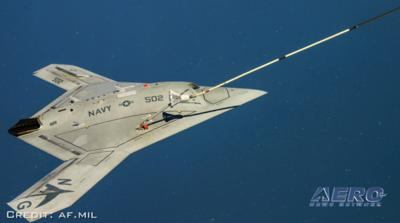Thu, Sep 14, 2017
Intelligence-Gathering A Possible Secondary Mission For The Aircraft
The U.S. Navy is working to finalize its MQ-25 drone program sometime in the next two years with a goal of operating unmanned aircraft off aircraft carriers that are capable of delivering fuel to other aircraft in flight.

Defense News reports that the first MQ-25 drones are set to deploy from the aircraft carriers Dwight C. Eisenhower and George H.W. Bush in 2019, but a deployment date in 2018 is also under considerations. But the Navy will have to make its business case for an earlier deployment.
The success of the program relies heavily on the Unmanned Carrier Aviation Mission Controls System (UMCS). The Common Control System (CCS) for the UMCS is being developed by the Strike Planning and Execution Systems office of the Naval Air Systems Command. Third-party developers will likely be given contracts for vehicle-specific capabilities, according to the report.
The GAO plans to spend in excess of $2 billion for the MQ-25 system. Contractors on the program include Northrop Grumman, General Atomics, Lockheed Martin and Boeing.
If the refueling mission proves successful, the MQ-25 could also be configured for intelligence gathering and surveillance, according to the report.
According to NAVAIR, the MQ-25 will be the first air system procured by the Navy's Unmanned Carrier Aviation Program Office. (PMA-268) It is comprised of three major architectural segments: an Air Segment (AS), a Control System & Connectivity (CS&C) Segment, and a Carrier (CVN) Segment.
AS– Includes the MQ-25 UAS, which is composed of the MQ-25A Stingray air vehicle and associated support and handling equipment including the deck handling system, spares and repair materials.
CS&C – Includes the Unmanned Carrier Aviation (UCA) Mission Control System (UMCS) and its associated communication equipment; the Distributed Common Ground Station-Navy (DCGS-N) mission support functionality; all network based interfaces and routing equipment required to control the Stingray; and all required modifications to existing networks and C4I system infrastructure to enable tasking, collection, processing, exploitation and dissemination (TCPED) of the Stingray’s ISR information.
CVN – Composed of CVN ships’ spaces allocated to UCA as well as installed ship systems and modifications necessary for interface with the Air and CS&C segments. CVN systems important to the MQ-25 include aircraft launch and recovery systems, data dissemination systems (including radio terminals and antennas), and deck operations systems.
(Image from file)
More News
Also: Vertical Flight Society, NBAA Maintenance Conference, GA Honored, AMT Scholarship For the first time, students from Embry-Riddle’s Daytona Beach, Florida, campus took t>[...]
Hazardous Weather Information Summary of significant meteorological information (SIGMET/WS), convective significant meteorological information (convective SIGMET/WST), urgent pilot>[...]
"The need for innovation at speed and scale is greater than ever. The X-62A VISTA is a crucial platform in our efforts to develop, test and integrate AI, as well as to establish AI>[...]
(FAA) Inspector Observed That Both Fuel Tanks Were Intact And That Only A Minimal Amount Of Fuel Remained In Each Analysis: According to the pilot, approximately 8 miles from the d>[...]
“Pyka’s Pelican Cargo is unlike any other UAS solution on the market for contested logistics. We assessed a number of leading capabilities and concluded that the Pelica>[...]
 Airborne-Flight Training 05.09.24: ERAU at AIAA, LIFT Diamond Buy, Epic A&P
Airborne-Flight Training 05.09.24: ERAU at AIAA, LIFT Diamond Buy, Epic A&P ANN's Daily Aero-Term (05.07.24): Hazardous Weather Information
ANN's Daily Aero-Term (05.07.24): Hazardous Weather Information Aero-News: Quote of the Day (05.07.24)
Aero-News: Quote of the Day (05.07.24) NTSB Final Report: Cessna 150
NTSB Final Report: Cessna 150 Aero-News: Quote of the Day (05.08.24)
Aero-News: Quote of the Day (05.08.24)



